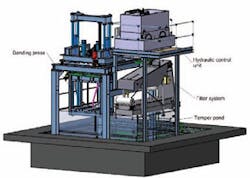A new hot-forming technology has been developed by an unlikely source — a machine builder that specializes in molds for plastic processing. BBG GmbH designed a machine for Lemken, a German manufacturer of agricultural machinery. It will be installed at a Lemken plant manufacturing cultivating implements in India.
The new system consists of a forming press coupled to a hardening unit, with a dipping tank for thermal control. In the first step, specially developed tools are used to form the steel components at temperatures over 1,600°F (900°C) in the forming unit. With the help of a complex hydraulic system, the forces and speeds required to form the special shapes can be generated and controlled with precision.
BBG previously collaborated to build hardening presses for another manufacturer. Currently, it manufactures a bending/hardening system that Lemken uses to form and harden steel components for agricultural machinery. In the process, the company used the expertise gained in nearly 40 years of designing and producing mold carrier systems for polyurethane processing, in particular for the automotive industry.
With its new machine, BBG said it has met Lemken’s stringent quality and performance requirements for its components thanks to a very sturdy mechanical design that was developed from CAD systems.
Following hot forming, the still-hot steel components are dipped in a tank filled with a specially derived solution. This step must be completed within a few seconds for the components to achieve the required hardness values.
Heat dissipation and the filtration of the liquid presented a significant challenge to the machine’s designers. Pumps are used to agitate the liquid. The liquid must be filtered, and its temperature must vary only within a very narrow tolerance around the optimal working temperature (around 90°F or 30°C.) It was necessary to adopt methods to compensate for the heat input of the red-hot steel components and for the ambient temperature, which may rise over 100°F during the summer in India.
The machine is being built now and planning is underway for the installation at in October at Lemken’s plant site in Nagpur, India. Before shipment, the equipment will be assembled, commissioned, and thoroughly tested.
BBG said the assignment represents a successful demonstration of its plan to increase its sales to non-automotive industries by 50% by 2012. It has established competence areas in tool construction and engineering products, and its development contracts and production capabilities for construction and solar-energy industries continue to grow.
